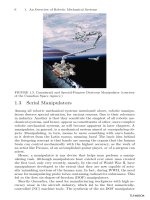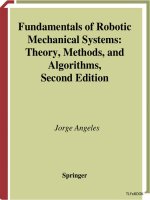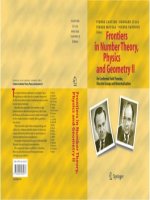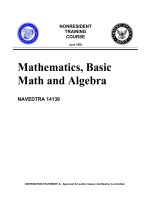singular perturbation theory - math and analyt technique w. appl to engineering - r. johnson
Bạn đang xem bản rút gọn của tài liệu. Xem và tải ngay bản đầy đủ của tài liệu tại đây (6.69 MB, 309 trang )
SINGULAR PERTURBATION THEORY
MATHEMATICAL AND ANALYTICAL TECHNIQUES
WITH APPLICATIONS TO ENGINEERING
MATHEMATICAL AND ANALYTICAL TECHNIQUES
WITH APPLICATIONS TO ENGINEERING
Alan Jeffrey, Consulting Editor
Published:
Inverse Problems
A. G. Ramm
Singular
Perturbation Theory
R. S. Johnson
Forthcoming:
Methods
for Constructing Exact Solutions of Partial Differential Equations
with
Applications
S. V. Meleshko
The
Fast Solution of Boundary Integral Equations
S. Rjasanow and O. Steinbach
Stochastic
Differential Equations with Applications
R. Situ
SINGULAR PERTURBATION THEORY
MATHEMATICAL AND ANALYTICAL TECHNIQUES WITH
APPLICATIONS TO ENGINEERING
R. S. JOHNSON
Springer
eBook ISBN: 0-387-23217-6
Print ISBN: 0-387-23200-1
Print ©2005 Springer Science + Business Media, Inc.
All rights reserved
No part of this eBook may be reproduced or transmitted in any form or by any means, electronic,
mechanical, recording, or otherwise, without written consent from the Publisher
Created in the United States of America
Boston
©2005 Springer Science + Business Media, Inc.
Visit Springer's eBookstore at:
and the Springer Global Website Online at:
To Ros, who still, after nearly 40 years,
sometimes listens when I extol the wonders of
singular perturbation theory, fluid mechanics or water waves
—usually on a long trek in the mountains.
This page intentionally left blank
CONTENTS
Foreword
xi
Preface
xiii
1.
Mathematical preliminaries
1
1.1
1.2
1.3
1.4
1.5
1.6
1.7
1.8
1.9
Some introductory examples
2
Notation
10
Asymptotic sequences and asymptotic expansions
13
Convergent series versus divergent series
16
Asymptotic expansions with a parameter 20
Uniformity or breakdown
22
Intermediate variables and the overlap region
26
The matching principle
28
Matching with logarithmic terms
32
1.10
Composite expansions
35
Further Reading
40
Exercises
41
viii
Contents
2.
Introductory applications
47
47
2.1
2.2
2.3
2.4
2.5
2.6
2.7
2.8
Roots of equations
Integration of functions represented by asymptotic
expansions 55
Ordinary differential equations: regular problems
59
Ordinary differential equations: simple singular problems
66
Scaling of differential equations
75
Equations which exhibit a boundary-layer behaviour
80
Where is the boundary layer?
86
Boundary layers and transition layers
90
Further Reading
103
Exercises
104
3.
Further applications
115
3.1
3.2
3.3
3.4
A regular problem
116
Singular problems I
118
Singular problems II
128
Further applications to ordinary differential equations
139
Further Reading
147
Exercises
148
4.
The method of multiple scales
157
4.1
4.2
4.3
4.4
4.5
4.6
Nearly linear oscillations
157
Nonlinear oscillators
165
Applications to classical ordinary differential equations
168
Applications to partial differential equations
176
A limitation on the use of the method of multiple scales
183
Boundary-layer problems
184
Further Reading
188
Exercises
188
5.
Some worked examples arising from physical problems
197
5.1
5.2
5.3
5.4
5.5
Mechanical & electrical systems
198
Celestial mechanics
219
Physics of particles and of light
226
Semi- and superconductors 235
Fluid mechanics
242
ix
5.6
5.7
Extreme thermal processes
255
Chemical and biochemical reactions
262
Appendix: The Jacobian Elliptic Functions
269
Answers and Hints
271
References
283
Subject Index
287
This page intentionally left blank
FOREWORD
The importance of mathematics in the study of problems arising from the real world,
and the increasing success with which it has been used to model situations ranging
from the purely deterministic to the stochastic, is well established. The purpose of the
set of volumes to which the present one belongs is to make available authoritative, up
to date, and self-contained accounts of some of the most important and useful of these
analytical approaches and techniques. Each volume provides a detailed introduction to
a specific subject area of current importance that is summarized below, and then goes
beyond this by reviewing recent contributions, and so serving as a valuable reference
source.
The progress in applicable mathematics has been brought about by the extension and
development of many important analytical approaches and techniques, in areas both
old and new, frequently aided by the use of computers without which the solution of
realistic problems would otherwise have been impossible.
A case in point is the analytical technique of singular perturbation theory which
has a long history. In recent years it has been used in many different ways, and its
importance has been enhanced by it having been used in various fields to derive
sequences of asymptotic approximations, each with a higher order of accuracy than its
predecessor. These approximations have, in turn, provided a better understanding of
the subject and stimulated the development of new methods for the numerical solution
of the higher order approximations. A typical example of this type is to be found in
the general study of nonlinear wave propagation phenomena as typified by the study
of water waves.
xii
Foreword
Elsewhere, as with the identification and emergence of the study of inverse problems,
new analytical approaches have stimulated the development of numerical techniques
for the solution of this major class of practical problems. Such work divides naturally
into two parts, the first being the identification and formulation of inverse problems,
the theory of ill-posed problems and the class of one-dimensional inverse problems,
and the second being the study and theory of multidimensional inverse problems.
On occasions the development of analytical results and their implementation by
computer have proceeded in parallel, as with the development of the fast boundary
element methods necessary for the numerical solution of partial differential equations
in several dimensions. This work has been stimulated by the study of boundary inte-
gral equations, which in turn has involved the study of boundary elements, collocation
methods, Galerkin methods, iterative methods and others, and then on to their im-
plementation in the case of the Helmholtz equation, the Lamé equations, the Stokes
equations, and various other equations of physical significance.
A major development in the theory of partial differential equations has been the
use of group theoretic methods when seeking solutions, and in the introduction of
the comparatively new method of differential constraints. In addition to the useful
contributions made by such studies to the understanding of the properties of solu-
tions, and to the identification and construction of new analytical solutions for well
established equations, the approach has also been of value when seeking numerical
solutions. This is mainly because of the way in many special cases, as with similarity
solutions, a group theoretic approach can enable the number of dimensions occurring
in a physical problem to be reduced, thereby resulting in a significant simplification
when seeking a numerical solution in several dimensions. Special analytical solutions
found in this way are also of value when testing the accuracy and efficiency of new
numerical schemes.
A different area in which significant analytical advances have been achieved is in
the field of stochastic differential equations. These equations are finding an increasing
number of applications in physical problems involving random phenomena, and oth-
ers that are only now beginning to emerge, as is happening with the current use of
stochastic models in the financial world. The methods used in the study of stochastic
differential equations differ somewhat from those employed in the applications men-
tioned so far, since they depend for their success on the Ito calculus, martingale theory
and the Doob-Meyer decomposition theorem, the details of which are developed as
necessary in the volume on stochastic differential equations.
There are, of course, other topics in addition to those mentioned above that are of
considerable practical importance, and which have experienced significant develop-
ments in recent years, but accounts of these must wait until later.
Alan Jeffrey
University of Newcastle
Newcastle upon Tyne
United Kingdom
PREFACE
The theory of singular perturbations has been with us, in one form or another, for a little
over a century (although the term ‘singular perturbation’ dates from the 1940s). The
subject, and the techniques associated with it, have evolved over this period as a response
to the need to find approximate solutions (in an analytical form) to complex problems.
Typically, such problems are expressed in terms of differential equations which contain
at least one small parameter, and they can arise in many fields: fluid mechanics, particle
physics and combustion processes, to name but three. The essential hallmark of a
singular perturbation problem is that a simple and straightforward approximation (based
on the smallness of the parameter) does not give an accurate solution throughout the
domai
n
of that solution. Perforce, this leads to different approximations being valid in
different parts of the domain (usually requiring a ‘scaling’ of the variables with respect to
the parameter). This in turn has led to the important concepts of breakdown, matching,
and so on.
Mathematical problems that make extensive use of a small parameter were probably
first described by J. H. Poincaré (1854–1912) as part of his investigations in celestial
mechanics. (The small parameter, in this context, is usually the ratio of two masses.)
Although the majority of these problems were not obviously ‘singular’—and Poincaré
did not dwell upon this—some are; for example, one is the earth-moon-spaceship
problem mentioned in Chapter 2. Nevertheless, Poincaré did lay the foundations for
the technique that underpins our approach: the use of asymptotic expansions. The
notion of a singular perturbation problem was first evident in the seminal work of L.
Prandtl (1874–1953) on the viscous boundary layer (1904). Here, the small parameter is
xiv
Preface
the inverse Reynolds number and the equations are based on the classical Navier-Stokes
equation of fluid mechanics. This analysis, coupled with small-Reynolds-number ap-
proximations that were developed at about the same time (1910), prepared the ground
for a century of singular perturbation work in fluid mechanics. But other fields over
the century also made important contributions, for example: integration of differential
equations, particularly in the context of quantum mechanics; the theory of nonlinear
oscillations; control theory; the theory of semiconductors. All these, and many others,
have helped to develop the mathematical study of singular perturbation theory, which
has, from the mid-1960s, been supported and made popular by a range of excellent
text books and research papers. The subject is now quite familiar to postgraduate stu-
dents in applied mathematics (and related areas) and, to some extent, to undergraduate
students who specialise in applied mathematics. Indeed, it is an essential tool of the
modern applied mathematician, physicist and engineer.
This book is based on material that has been taught, mainly by the author, to MSc
and research students in applied mathematics and engineering mathematics, at the
University of Newcastle upon Tyne over the last thirty years. However, the presentation
of the introductory and background ideas is more detailed and comprehensive than has
been offered in any particular taught course. In addition, there are many more worked
examples and set exercises than would be found in most taught programmes. The style
adopted throughout is to explain, with examples, the essential techniques, but without
dwelling on the more formal aspects of proof, et cetera; this is for two reasons. Firstly, the
aim of this text is to make all the material readily accessible to the reader who wishes
to learn and use the ideas to help with research problems and who (in all likelihood)
does not have a strong mathematical background (or who is not that concerned about
these niceties). And secondly, many of the results and solutions that we present cannot
be recast to provide anything that resembles a routine proof of existence or asymptotic
correctness. Indeed, in many cases, no such proof is available, but there is often ample
evidence that the results are relevant, useful and probably correct.
This text has been written in a form that should enable the relatively inexperienced
(or new) worker in the field of singular perturbation theory to learn and apply all the
essential ideas. To this end, the text has been designed as a learning tool (rather than
a reference text, for example), and so could provide the basis for a taught course. The
numerous examples and set exercises are intended to aid this process. Although it is
assumed that the reader is quite unfamiliar with singular perturbation theory, there
are many occasions in the text when, for example, a differential equation needs to be
solved. In most cases the solution (and perhaps the method of solution) are quoted, but
some readers may wish to explore this aspect of mathematical analysis; there are many
good texts that describe methods for solving (standard) ordinary and partial differential
equations. However, if the reader can accept the given solution, it will enable the main
theme of singular perturbation theory to progress more smoothly.
Chapter 1 introduces all the mathematical preliminaries that are required for the
study of singular perturbation theory. First, a few simple examples are presented that
highlight some of the difficulties that can arise, going some way towards explaining
the need for this theory. Then notation, definitions and the procedure of finding
xv
asymptotic expansions (based on a parameter) are described. The notions of uniformity
and breakdown are introduced, together with the important concepts of scaling and
matching. Chapter 2 is devoted to routine and straightforward applications of the
methods developed in the previous chapter. In particular, we discuss how these ideas
can be used to find the roots of equations and how to integrate functions represented
by a number of matched asymptotic expansions. We then turn to the most significant
application of these methods: the solution of differential equations. Some simple regular
(i.e. not singular) problems are discussed first—these are rather rare and of no great
importance—followed by a number of examples of singular problems, including some
that exhibit boundary or transition layers. The role of scaling a differential equation is
given some prominence.
In Chapter 3, the techniques of singular perturbation theory are applied to more
sophisticated problems, many of which arise directly from (or are based upon) im-
portant examples in applied mathematics or mathematical physics. Thus we look at
nonlinear wave propagation, supersonic flow past a thin aerofoil, solutions of Laplace’s
equation, heat transfer to a fluid flowing through a pipe and an example taken from gas
dynamics. All these are classical problems, at some level, and are intended to show the
efficacy of these techniques. The chapter concludes with some applications to ordinary
differential equations (such as Mathieu’s equation) and then, as an extension of some
of the ideas already developed, the method of strained coordinates is presented.
One of the most general and most powerful techniques in the armoury of singular
perturbation theory is the method of multiple scales. This is introduced, explained and
developed in Chapter 4, and then applied to a wide variety of problems. These in-
clude linear and nonlinear oscillations, classical ordinary differential equations (such as
Mathieu’s equation—again—and equations with turning points) and the propagation
of dispersive waves. Finally, it is shown that the method of multiple scales can be used
to great effect in boundary-layer problems (first mentioned in Chapter 2).
The final chapter is devoted to a collection of worked examples taken from a wide
range of subject areas. It is hoped that each reader will find something of interest here,
and that these will show—perhaps more clearly than anything that has gone before—
the relevance and power of singular perturbation theory. Even if there is nothing of
immediate interest, the reader who wishes to become more skilled will find these a
useful set of additional examples. These are listed under seven headings: mechanical
& electrical systems; celestial mechanics; physics of particles & light; semi- and su-
perconductors; fluid mechanics; extreme thermal processes; chemical & biochemical
reactions.
Throughout the text, worked examples are used to explain and describe the ideas,
which are reinforced by the numerous exercises that are provided at the end of each of
the first four chapters. (There are no set exercises in Chapter 5, but the extensive ref-
erences can be investigated if more information is required.) Also at the end of each of
Chapters 1–4 is a section of further reading which, in conjunction with the references
cited in the body of the chapter, indicate where relevant reference material can be
found. The references (all listed at the end of the book) contain both texts and research
papers. Sections in each chapter are numbered following the decimal pattern, and
xvi
Preface
equations are numbered according to the chapter in which they appear; thus equation
(2.3) is the third (numbered) equation in Chapter 2. The worked examples follow a
similar pattern (so E3.3 is the third worked example in Chapter 3) and each is given a
title in order to help the reader—perhaps—to select an appropriate one for study; the
end of a worked example is denoted by a half-line across the page. The set exercises
are similarly numbered (so Q3.2 is the second exercise at the end of Chapter 3)
and, again, each is given a title; the answers (and, in some cases, hints and intermediate
steps
)
are given at the end of the book (where A3.2 is the answer to Q3.2). A detailed
and comprehensive subject index is provided at the very end of the text.
I wish to put on record my thanks to Professor Alan Jeffrey for encouraging me
to write this text, and to Kluwer Academic Publishers for their support throughout.
I must also record my heartfelt thanks to all the authors who came before me (and
most are listed in the References) because, without their guidance, the selection of
material for this text would have been immeasurably more difficult. Of course, where
I have based an example on something that already exists, a suitable acknowledge-
ment is given, but I am solely responsible for my version of it. Similarly, the clarity
and accuracy of the figures rests solely with me; they were produced either in Word
(as was the main text), or as output from Maple, or using SmartDraw.
1.
MATHEMATICAL PRELIMINARIES
Before we embark on the study of singular perturbation theory, particularly as it is rele-
vant to the solution of differential equations, a number of introductory and background
ideas need to be developed. We shall take the opportunity, first, to describe (without
being too careful about the formalities) a few simple problems that, it is hoped, explain
the need for the approach that we present in this text. We discuss some elementary dif-
ferential equations (which have simple exact solutions) and use these—both equations
and solutions–to motivate and help to introduce some of the techniques that we shall
present. Although we will work, at this stage, with equations which possess known
solutions, it is easy to make small changes to them which immediately present us with
equations which we cannot solve exactly. Nevertheless, the approximate methods that
we will develop are generally still applicable; thus we will be able to tackle far more
difficult problems which are often important, interesting and physically relevant.
Many equations, and typically (but not exclusively) we mean differential equations,
that are encountered in, for example, science or engineering or biology or economics,
are too difficult to solve by standard methods. Indeed, for many of them, it appears
that there is no realistic chance that, even with exceptional effort, skill and luck, they
could ever be solved. However, it is quite common for such equations to contain
parameters which are small; the techniques and ideas that we shall present here aim to
take advantage of this special property.
The second, and more important plan in this first chapter, is to introduce the ideas,
definitions and notation that provide the appropriate language for our approach. Thus
2
1. Mathematical preliminaries
we will describe : order, asymptotic sequences, asymptotic expansions, expansions with
parameters, non-uniformities and breakdown, matching.
1.1
SOME INTRODUCTORY EXAMPLES
We will present four simple ordinary differential equations–three second-order and
one first-order. In each case we are able to write down the exact solution, and we will
use these to help us to interpret the difficulties that we encounter. Each equation will
contain a small parameter, which we will always take to be positive; the intention
is to obtain, directly from the equation, an approximate solution which is valid for
small
E1.1
An oscillation problem
We consider the constant coefficient equation
with x(0) = 0, (where the dot denotes the derivative with respect to t); this
is an initial-value problem. Let us assume that there is a solution which can be written
as a power series in
where each of the is not a function of The equation (1.1) then gives
where we again use, for convenience, the dot to denote derivatives. We write (1.3) in
the form
and, since the right-hand side is precisely zero, all the must vanish; thus
we require
(Remember that each does not depend on
The two initial conditions give
3
and, using the same argument as before, we must choose
where the ‘1’ in the second condition is accommodated by (If the initial
conditions were, say, then we would have to select
Thus the first approximation is represented by the problem
the general solution is
where A and B are arbitrary constants which, to satisfy the initial conditions, must
take the values A= 1, B = 0. The solution is therefore
The problem for the second term in the series becomes
The solution of this equation requires the inclusion of a particular integral, which here
is the complete general solution is therefore
where C and
D
are arbitrary constants. (The particular integral can be found by any
one of the standard methods e.g. variation of parameters, or simply by trial-and-error.)
The given conditions then require that and D = 0 i.e.
and so our series solution, at this stage, reads
Let us now review our results.
The original differential equation, (1.1), should be recognised as the harmonic
oscillator equation for all
and, as such, it possesses bounded, periodic solutions.
The first term in our series, (1.5), certainly satisfies both these properties, whereas
the second fails on both counts. Thus the series, (1.7), also fails: our approximation
4
1. Mathematical preliminaries
procedure has generated a solution which is not periodic and for which the amplitude
grows without bound as Yet the exact solution is simply
which is easily obtained by scaling out the factor, by working with
rather than t. (The ‘
e
’ subscript here is used to denote the exact solution.) It is now an
elementary exercise to check that (1.8) and (1.7) agree, in the sense that the expansion
of (1.8), for small and fixed t, reproduces (1.7). (A few examples of expansions
are set as exercises in Q1.1, 1.2.) This process immediately highlights one of our
difficulties, namely, taking first and then allowing this is a classic case
of a non-uniform limiting process i.e. the answer depends on the order in which the limits
are taken. (Examples of simple limiting processes can be found in Q1.4.) Clearly, any
approximate methods that we develop must be able to cope with this type of behaviour.
So, for example, if it is known (or expected) that bounded, periodic solutions exist,
the approach that we adopt must produce a suitable approximation to this solution.
We have taken some care in our description of this first example because, at this
stage, the approach and ideas are new; we will present the other examples with slightly
less detail. However, before we leave this problem, there is one further observation
to make. The original equation, (1.1), can be solved easily and directly; an associated
problem might be
with appropriate initial data. This describes an oscillator for which the frequency
depends on the value of x(t) at that instant—it is a nonlinear problem. Such equations
are much more difficult to solve; our techniques have got to be able to make some
useful headway with equations like (1.9).
E1.2
A first-order equation
We consider the equation
with Again, let us seek a solution in the form
and then obtain
or
5
we use the prime to denote the derivative. Thus we require
with the boundary conditions
The solution for is immediately
but this result is clearly unsatisfactory: the solution for grows exponentially, whereas
the solution of equation (1.10) must decay for
(because then Per-
haps the next term in the series will correct this behaviour for large enough x; we have
Thus
and we require A = 0; the series solution so far is therefore
However, this is no improvement; now, for sufficiently large x, the second term dom-
inates and the solution grows towards Let us attempt to clarify the situation by
examining the exact solution.
We write equation (1.10) as
the general solution is therefore
and, with
C
= 1 to satisfy the given condition at x = 0, this yields
Clearly the series, (1.12), is recovered directly by expanding the exact solution, (1.13),
in for fixed x, so that we obtain
Equally clearly, this procedure will give a very poor approximation for large x; indeed,
for x about the size of the approximation altogether fails. A neat way to see this
is to redefine x as this is called scaling and will play a crucial rôle in what
6
1. Mathematical preliminaries
we describe in this text. If we now consider small, for X fixed, the size of x is now
proportional to and the results are very different:
indeed, in this example, we cannot even write down a suitable approximation of (1.14)
for small The expression in (1.14) attains a maximum at X= 1/2, and for larger X
the function tends to zero.
We observe that any techniques that we develop must be able to handle this situation;
indeed, this example introduces the important idea that the function of interest may
take different (approximate) forms for different sizes of x. This, ultimately, is not
surprising, but the significant ingredient here is that ‘different sizes’ are measured in
terms of the small parameter, We shall be more precise about this concept later.
E1.3
Another simple second-order equation
This time we consider
with
(The use of here, rather than is simply an algebraic convenience, as will become
clear; obviously any small positive number could be represented by or —or anything
equivalent, such
as or
et
cetera.)
Presumably—or
so we
will
assume—a
first
approximation to equation (1.15), for small
is just
but this problem has no solution. The general solution is where A and
B are the two arbitrary constants, and no choice of them can satisfy both conditions.
In a sense, this is a more worrying situation than that presented by either of the two
previous examples: we cannot even get started this time.
The exact solution is
and the difficulties are immediately apparent: with x fixed, gives
but then how do we accommodate the condition at infinity? Correspondingly, with
and fixed, we obtain and now how can we obtain the dependence
on As we can readily see, to treat and x separately is not appropriate here—we
need to work with a scaled version of x (i.e.
The choice of such a variable
avoids the non-uniform limiting process: and
7
E1.4
A two-point boundary-value problem
Our final introductory example is provided by
with and given. This equation contains the parameter in two places:
multiplying the higher derivative, which is critical here (as we will see), and adjusting
the coefficient of the other derivative by a small amount. This latter appearance of the
parameter is altogether unimportant—the coefficient is certainly close to unity—and
serves only to make more transparent the calculations that we present.
Once again, we will start by seeking a solution which can be represented by the
series
so that we obtain
the shorthand notation for derivatives is again being employed. Thus we have the set
of differential equations
with boundary conditions written as
where and are given (but we will assume that they are not functions of The
general solution for is
but it is not at all clear how we can determine A. The difficulty that we have in this
example is that we must apply two boundary conditions, which is patently impossible
(unless some special requirement is satisfied). So, if we use
we obtain
if, by extreme good fortune, we have then we also satisfy the second
boundary condition (on x = 1). Of course, in general, this will not be the case; let us
proceed with the problem for which Thus the solution using does
8
1. Mathematical preliminaries
not satisfy and the solution
does not satisfy Indeed, we have no way of knowing which, if either, is
correct; thus there is little to be gained by solving the problem:
(We note that, since we must have and then there is, ex-
ceptionally, a solution of the complete problem: for But we still
do not know
As in our previous examples, let us construct and examine the exact solution. Equa-
tion (1.16) is a second order, constant coefficient, ordinary differential equation and
so we may seek a solution in the form
i.e.
The general solution is therefore
and, imposing the two boundary conditions, this becomes
(We can note here that the contribution from the term is absent in the
special case
we proceed with the problem for which
This solution, (1.22), is defined for and with let us select any
and, for this x fixed, allow (where denotes tending to zero
through the positive numbers). We observe that the terms and
vanish rapidly in this limit, leaving
this is our approximate solution given in (1.20). (Some examples that explore the
relative sizes of exp(x) and ln(x) can be found in Q1.5.) Thus one of the possible
options for introduced above, is indeed correct. However, this solution is, as
already noted, incorrect on x = 0 (although, of course, The difficulty
is plainly with the term for any x > 0 fixed, as this vanishes
exponentially, but on x = 0 this takes the value 1 (one). In order to examine the rôle
of this term, as we need to retain it (but not to restrict ourselves to x = 0); as









